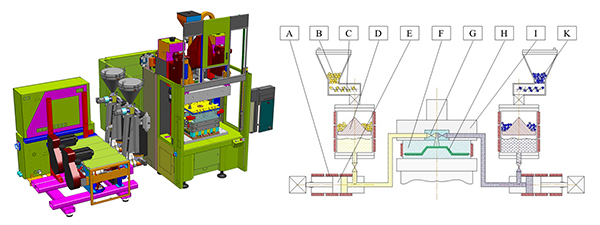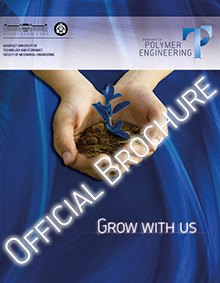Development of novel carbon fiber reinforcement structures for the designable reinforcement of mass-produced polymer composite products
Dr. András Suplicz
Project summary
The project aims to develop carbon fiber composite technologies that present affordable and lightweight solutions for mass produced cars. With these products, automotive parts can be lighter and therefore less energy is used when the cars are manufactured and used. One technology that we intend to develop further is the sheet molding compound (SMC) procedure. Its main advantage is that there is less waste during manufacturing than in the case of conventional long-fiber composite technologies (RTM, Prepreg). This technology will be developed and its disadvantage eliminated so that there will be controlled fiber orientation, and therefore plannable load-bearing in the structure. Another technology that we intend to develop further is thermoplastic resin infusion, which can eliminate the disadvantages of cross-linked base materials, and combines the excellent impregnation capability of cross-linked systems and the versatile processability and recyclability of thermoplastic systems. Development here also focuses on the simpler and more cost-effective achievement of the planned orientation. The project therefore offers alternative solutions for the more effective utilization of available energy and material resources, as it is likely that in the near future, before 2025, demand will grow considerably for light and strong structural materials. The goal of the project is to insert the PX35 carbon fiber roving (which has a high value for money, as a textile-type precursor-based carbon fiber, with a production capacity increase of 6 months, in contrast to competitors' 18-24 months of implementation, stable long-term sustainable pricing.) manufactured by Zoltek Zrt. in an oriented way in the case of SMC and thermoplastic resin infusion, to utilize its advantageous properties to the fullest. The SMC technology, although it is cost effective, currently produces considerable worse mechanical properties than long-fiber composite technologies. Thermoplastic resin infusion in its present state produces excellent mechanical and recycling properties, but it is not competitive at present because of the uncertainty of preform manufacturing and the technology. The suggested new hybrid SMC technology and hybrid thermoplastic resin infusion, however, provides a competitive advantage to Zoltek Zrt. with which they can produce and sell to the car industry considerably more (up to 50%) carbon fiber (PX35). Technologies to be developed in the project in public transport, shipbuilding, product shipment, and sports equipment – in all areas where the light weight is a benefit – but also in household appliances and robotics. The novelty of the project is – in addition to oriented reinforcement – better adhesion between the 50K rovings and matrix materials, which leads to even higher strength in the products. For the development project, Zoltek will use the new layup strategy (called KASSEN) of its PX35 carbon fibers, which will improve manufacturing. The success of the project is ensured by the many years of experience of Zoltek Zrt. in manufacturing carbon fibers and developing their manufacturing technology, and the results achieved by the Department of Polymer Engineering of BME in research, development and innovation, and its research background. This is further reinforced by the cooperation agreement between the company and the Department, as a result of which, there has been several years of cooperation in areas of basic science.
Project results


Project-related publications
- Horváth Sz., Kovács J. G.: Effect of processing parameters and wall thickness on the strength of injection molded products. Periodica Polytechnica-Mechanical Engineering, 68, 78-84 (2024) 10.3311/PPme.24068 IF=1.3 Q3
- Kotrocz L., Bakonyi P.: Investigation the temperature-dependent surface mechanical properties of PolyJet printed samples by cyclic indentation testing in a DMA system. Results in Materials, 17, 100360/1-100360/8 (2023) 10.1016/j.rinma.2022.100360
- Párizs R. D., Török D., Ageyeva T., Kovács J. G.: Multiple in-mold sensors for quality and process control in injection molding. Sensors, 23, 1735/1-1735/18 (2023) 10.3390/s23031735 IF=3.4 Q2
- Szuchács A., Ageyeva T., Kovács J. G.: Modeling and measuring the bonding strength of overmolded polymer parts. Polymer Testing, 125, 108133/1-108133/15 (2023) 10.1016/j.polymertesting.2023.108133 IF=5 D1
- Török D., Ageyeva T., Boros R., Kovács Á., Kovács J. G.: Developing a method for evaluating color changeover in a hot-runner multi-cavity injection mold. Polymer Testing, 115, 107759/1-107759/9 (2022) 10.1016/j.polymertesting.2022.107759 IF=5.1 D1
- Boros R., Ageyeva T., Golcs Á., Krafcsik O. H., Kovács J. G.: Plasma treatment to improve the adhesion between ABS and PA6 in hybrid structures produced by injection overmolding. Polymer Testing, 106, 107446/1-107446/11 (2022) 10.1016/j.polymertesting.2021.107446 IF=5.1 D1
- Semperger O. V., Török D., Suplicz A.: Development and Analysis of an In-Mold Coating Procedure for Thermoplastic Resin Transfer Molding to Produce PA6 Composites with a Multifunctional Surface. Periodica Polytechnica-Mechanical Engineering, 66, 350-360 (2022) 10.3311/PPme.21048 IF=1.3
- Török D., Zink B., Ageyeva T., Hatos I., Zobač M., Fekete I., Boros R., Hargitai H., Kovács J. G.: Laser powder bed fusion and casting for an advanced hybrid prototype mold. Journal of Manufacturing Processes, 81, 748-758 (2022) 10.1016/j.jmapro.2022.07.034 IF=6.2 Q2
- Zink B., Kovács J. G.: Pressure‐dependent heat transfer coefficient measurement for thermoplastic melts. Polymer Engineering and Science, 62, 1137-1146 (2022) 10.1002/pen.25912 IF=3.2 Q2
- Krizsma Sz. G., Suplicz A.: Comprehensive in-mould state monitoring of material jetting additively manufactured and machined aluminium injection moulds. Journal of Manufacturing Processes, 84, 1298-1309 (2022) 10.1016/j.jmapro.2022.10.070 IF=6.2 Q2
- Tóth Cs., Kovács N. K.: Comparison of the accuracy of analytical models for basalt fiber–reinforced poly(lactic acid) composites prepared by injection molding and fused filament fabrication. International Journal of Advanced Manufacturing Technology, 121, 3999–4010 (2022) 10.1007/s00170-022-09572-8 IF=3.4 Q2
- Párizs R. D., Török D., Ageyeva T., Kovács J. G.: Machine learning in injection molding: An industry 4.0 method of quality prediction. Sensors, 22, 2704/1-2704/16 (2022) 10.3390/s22072704 IF=3.9 Q2
- Petrény R., Tóth Cs., Mészáros L., Horváth A.: Development of electrically conductive hybrid composites with a poly(lactic acid) matrix, with enhanced toughness for injection molding, and material extrusion-based additive manufacturing. Heliyon, 8, e10287/1-e10287/8 (2022) 10.1016/j.heliyon.2022.e10287 IF=4 Q2
- Semperger O. V., Suplicz A.: The effect of the titanium dioxide nanoparticles on the morphology and degradation of polyamide 6 prepared by anionic ring-opening polymerization. Polymer Engineering and Science, 62, 2079-2088 (2022) 10.1002/pen.25990 IF=3.2 Q2
- Krizsma Sz. G., Suplicz A.: State-monitoring and product quality measurement of additively manufactured injection mould inserts. IOP Conference Series: Materials Science and Engineering, 1246, 012020/1-012020/8 (2022) 10.1088/1757-899X/1246/1/012020
- Szabó F., Suplicz A., Kovács J. G.: Development of injection molding simulation algorithms that take into account segregation. Powder Technology, 389, 368-375 (2021) 10.1016/j.powtec.2021.05.053 IF=5.64 Q1
- Krizsma Sz. G., Suplicz A.: Additív gyártástechnológiával előállított fröccsöntő szerszámbetétek üzem közbeni deformációinak vizsgálata. Polimerek, 7, 155-160 (2021)
- Semperger O. V., Pomlényi P., Suplicz A.: Felület-bevonatolási eljárás T-RTM technológiához. Polimerek, 7, 186-192 (2021)
- Rajamani P. K., Ageyeva T., Kovács J. G.: Personalized mass production by hybridization of additive manufacturing and injection molding. Polymers, 13, 309/1-309/19 (2021) 10.3390/polym13020309 IF=4.967 Q1
- Szuchács A., Ageyeva T., Boros R., Kovács J. G.: Bonding strength calculation in multicomponent plastic processing technologies. Materials And Manufacturing Processes, 36, 151-159 (2021) 10.1080/10426914.2021.1948052 IF=4.783 Q2
- Krizsma Sz. G., Kovács N. K., Kovács J. G., Suplicz A.: In-situ monitoring of deformation in rapid prototyped injection molds. Additive Manufacturing, 42, 102001/1-102001/8 (2021) 10.1016/j.addma.2021.102001 IF=11.632 D1
- Tábi T., Csézi G., Kovács N. K.: 3D nyomtatott biokompozit vázszerkezetű fröccsöntött termékek vizsgálata. Polimerek, 6, 1042-1046 (2020)
- Fris D. R., Szabó F.: Modelling of segregation during injection moulding. IOP Conference Series: Materials Science and Engineering, 903, 012022/1-012022/8 (2020) doi:10.1088/1757-899X/903/1/012022
- Semperger O. V., Suplicz A.: The effect of titanium dioxide on the moisture absorption of polyamide 6 prepared by T-RTM. in '12th Hungarian Conference on Materials Science Balatonkenese, Magyarország. 2019.10.13-2019.10.15,8 (2020)
- Fris D. R., Szabó F.: Hálófinomítási eljárás fejlesztése fröccsöntési szimulációs alkalmazásokhoz. in 'XXVIII. Nemzetközi Gépészeti Konferencia – OGÉT 2020 Online, . 2020.04.25.-2020.04.26,57-60 (2020)
- Suplicz A., Boros R., Semperger O. V.: Investigation of the interfacial adhesion of glass bead-filled multicomponent injection moulded composites. in '12th Hungarian Conference on Materials Science Balatonkenese, Magyarország. 2019.10.13-209.10.15,7 (2020)
- Boros R., Tóth N. Gy., Kovács J. G.: Ráfröccsöntéssel készült alkatrészek vizsgálati módszerének fejlesztése. in 'XXVIII. Nemzetközi Gépészeti Konferencia – OGÉT 2020 online konferencia. 2020.04.25.,41-44 (2020)
- Semperger O. V., Suplicz A.: The Effect of the Parameters of T-RTM on the Properties of Polyamide 6 Prepared by in Situ Polymerization. Materials, 13, 4-14 (2020) 10.3390/ma13010004 IF=3.623 Q1
- Tóth Cs., Kovács N. K.: Additív gyártástechnológiával készült, politejsav mátrixú kompozitok vizsgálata. Polimerek, 6, 926-930 (2020)
- Boros R., Sibikin I., Ageyeva T., Kovács J. G.: Development and Validation of a Test Mold for Thermoplastic Resin Transfer Molding of Reactive PA-6. Polymers, 12, 976/1-976/13 (2020) doi:10.3390/polym12040976 IF=4.329 Q1
- Tóth Cs., Kovács N. K.: Characterization of short fiber-reinforced polylactic acid composites produced with Fused Filament Fabrication (FFF). in '12th Hungarian Conference on Materials Science Balatonkenese, Magyarország. 2019.10.13-2019.10.15,8 (2020)
- Suplicz A., Semperger O. V., Kovács J. G.: Modeling the Thermal Conductivity Inhomogeneities of Injection-Molded Particle-Filled Composites, Caused by Segregation. Polymers, 11, 1691/1-1691/12 (2019) 10.3390/polym11101691 IF=3.426 Q1
- Semperger O. V., Suplicz A.: Titán-dioxid hatása az in-situ polimerizációval előállított poliamid 6 minták tulajdonságaira. Polimerek, 5, 730-733 (2019)
- Ageyeva T., Horváth Sz., Kovács J. G.: In-Mold Sensors for Injection Molding: On the Way to Industry 4.0. Sensors, 19, 3551/1-3551/21 (2019) 10.3390/s19163551 IF=3.275 Q1
- Ageyeva T., Sibikin I., Kovács J. G.: A Review of Thermoplastic Resin Transfer Molding: Process Modeling and Simulation. Polymers, 11, 1555/1-1555/28 (2019) 10.3390/polym11101555 IF=3.426 Q1






